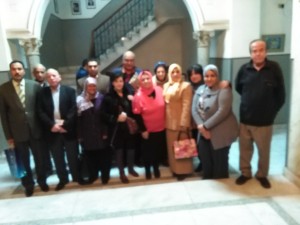Synopsis :
Issued: September 15 2002
Publisher : RoselYousef publishing House (Golden Books series)
Author : Ekbal Baraka ,chief editor of "HAWAA" the first and most popular weekly for Arab women.Columnist in Al Ahram daily.
A leading writer in a number of Arabic papers and issued 20 books since 1970.
The issue of the veiling has caused a great controversy among muslims all over the world since the mid seventies when veiling spread among muslim women as a sign of adhering to the instructions of the Quran.
“The veil: A new Vision” is a book that expresses the viewpoint of a modern Muslim woman, living in the third millennium, towards the veil.
It deals with the subject with courage and objectivity, referring to verdicts and fatwa of the old generations of jurisprudence with a critical and fresh eye.
The book was preceded by a number of articles in Al Ahram daily and Rosel Yousef weekly, that aroused a lot of comments by readers, and caused a vast controversy among intellectuals.
“ The veil: A new Vision" is an attempt at understanding and defending Islam with regards to a crucial issue that has never been settled among Muslims .
The book contains an introduction by the author , 8 chapters on Hijab: in history, Hijab in the Holy Quran, Hijab in the Prophet Mohamed's narrations, Hijab and Muslim identity ,Hijab and Chastity , Pros and cons plus 2 chapters : a historical background, Slavery before and after Islam.
ABSTRACT of “The veil, a Modern Viewpoint”
"The veil "by Ekbal Baraka
The veil in History
In ancient times fighting never stopped among tribes and peoples. The conquerors occupied the land, killed men, and captivated women and children of the defeated tribes and slavery was the universal social system among all peoples. All societies were divided into two social classes: free and slaves.
While men went away for hunting and fighting their women were exposed to rape and kidnapping.
The Assyrians (in Iraq) were harsh fighting people who lived on raiding on other tribes and invading their lands, they were the first people to impose the veiling on their women.
As means of protection of their kinswomen, they interned them behind locked doors (the Harem), and made them cover their bodies from head to heels with a uniform (a veil over loose robe) when they had to go out.
The veiling distinguished free women from bondmaids, and enslaved women who were forbidden from wearing that uniform.
In their penal code: slave-women who covered their hair or bodies and men who saw a slave woman wearing the uniform of a free woman and did not report to the authorities were to be flogged with a whip fifty times.
The veil in the Old Testament
It was mentioned in Genesis chapter 24 (64-65)
“And Rebecca lifted up her eyes, and when she saw Isaac, she lighted off the camel. For she had said unto the servant, what man is this that walketh in the field to meet us? And the servant had said it is my master: therefore she took a veil, and covered herself.”
And in 1 Corinthians chapter 11 (5-13)
“Every man prayeth or prophesieth having his head covered dishonoreth his head. But every woman that prayeth or prophesieth with her head uncovered dishonoreth her head: for that is even all one as if she was shaven.”
“For if the woman be not covered, let her also be shorn: but if it be shame for a woman to be shorn or shaven, let her be covered.”
Then the veiling spread as a habit among women of most kingdoms: Persia, Troy, Sparta, Byzantium, etc…
The veil in Islam
Muslim women in the days of Prophet Mohammed and his companions until the end of Omayyad dynasty used to accompany and help fighting men in the battlefields.
And when the Muslim Arabs invaded Persia they adopted their custom of the veiling and concealing their women and called it the Harem.
Persians predominated the Abbasside state and their habits and thoughts prevailed Islamic jurisprudence, so the veiling was made compulsory for all women, as a religious, obligation (rite) imposed with verdicts (Fatwa) by Muslim jurisconsults.
Women’s dress is mentioned twice in the Holy Quran:
1. (Al Ahzab 33-59) Prophet Mohammed is commanded to tell his wives and daughters and women of the believers to draw their cloaks (the veils) all over their bodies (i.e. screen themselves), hence they might be distinguished and not annoyed (harassed or seduced), better that they should be known as respectable women.
2. (Al Noor 30-31) Prophet Mohammed is commanded to tell believing men and women to cast down their gaze and keep away from adultery (avoid looking at forbidden parts and protect their private parts (genitalia), women to cover the openings of their robes by their the veils and refrain from showing off their ornaments to others than kinsmen.
3. All over the Holy Quoran women’s head or hair is not directly mentioned, nor is there an obligation of a certain uniform, and women are considered to be completely equitable to men: both are commanded to be chaste and modest, and keep away from adultery.
4. Nevertheless, old generations of Muslims compelled women to follow the example of the Prophet’s wives who were ordained to the veiling by a verse (53 & 59 Al Ahzab) in the Koran.
Wives of Prophet Mohammed are considered to be mothers of all believers, and the Muslims were ordained to keep distance and show reverence to them by addressing them from behind curtains. The meaning of the word the veil all over the Holy Quoran is a curtain or partition not a garment. Mothers of believers were ordained to be pious and speak nicely and with modesty, rest at home, go out only when necessary, refrain from over adornment, keep praying, giving alms and obey God and his Prophet. This is God’s will to keep them and all the household of Mohammed far above sins and impurity.
Although men and women were asked to follow example of the Prophet and obey his traditions, no verse in the Holy Koran invokes women to follow or imitate the Prophet’s wives.
The veil in the Hadith (Prophet’s narrations)
In the Hadith three narrations are attributed to Aisha, the Prophet’s wife.
1. One narration states that he said “It is not good for an adult woman to reveal any part of her body except face and hands “
2. Two narrations stating: “It is not correct that an adult woman reveals her body except face and half her arm “.
The first narration (face and hands) is open to suspicion because it was quoted by one man attributing it to Aisha whom he had not been contemporary with. The other two narrations contradict the first and were ignored by most jurisprudents because they allow woman to reveal half her harm.
Although the first narration is uncertain and not mentioned in five (out of six), of the Veritable Books of the Hadith (Al Sehah) the orthodox Muslims refer to it all the time and make it a proof that the Hijab (the veils and loose robes) an obligation on Muslim women.
The first hadith (narration) of revealing face and hands is rejected by the Hanabila, followers of Ahmed Ibn Hanbal, founder of one of the main sects in Islam, who considered it fictitious and uncertain, and were in favour of the Niquab only (covering a woman from head to heels). The Hanabila insist that every part of a woman’s body, even her nails and voice, is an Awra.
Since the mid-seventies fundamentals have reiterated verdicts of old generations of jurisprudents, and the veiling has been forced on Muslim women as a sign indicating Muslim identity , distinguishing Muslim women from non-Muslims. For political reasons, contemporary jurisprudents abstain from giving their own explanation of the Quran (Ijtihad), or issue verdicts that agree with the modern mentality, which has changed completely after the 10th century in which the door of Ijtihad had been closed .
The veil : A new Vision
بقلم: إقبـــــال بركة - في: الاثنين 16 أكتوبر 2017 - التصنيف: علوم إجتماعية
فعاليات

الجليد لصنع الله ابراهيم
يونيو 26, 2025
شاركنا في ندوة ينظمها المنتدى لمناقشة رواية الجليد...

العربية السعيدة في بيت يكن
إبريل 15, 2025
العربية السعيدة، لتوركل هانسن وترجمة سوسن كردوش قس...

الأديب: رؤية ومسيرة ... حوار مع إيلان بابيه عبر زووم
مارس 15, 2025
تمت هذه الحلقة في 15 مارس 2025 ، تستطيع الان مشاهد...

مسافر يبحث عن ماء
فبراير 17, 2025
تقيم نقابة اتحاد كتاب مصرشعبة أدب الرحلات تحت رعاي...
